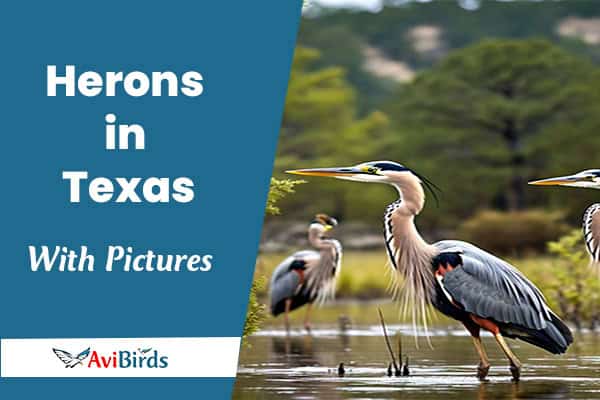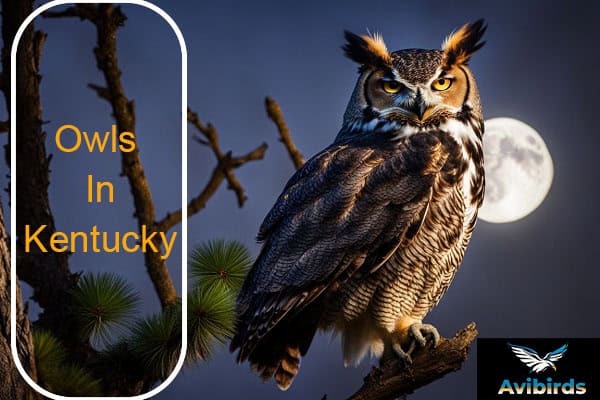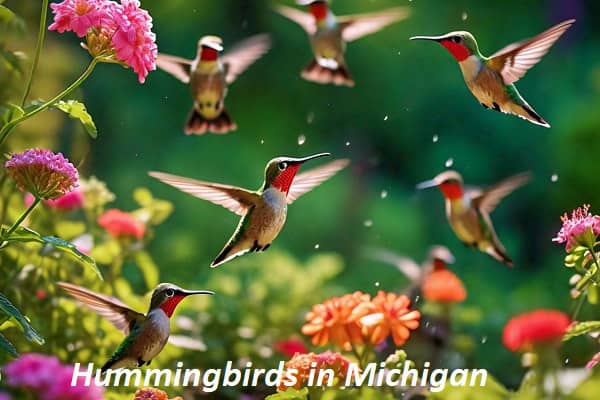7 Types Of Hummingbirds Found In Virginia (ID Guide)
Are you ready to explore the amazing world of Hummingbirds in Virginia? Their shiny feathers catch the sunlight beautifully. Virginia is a great place to see these amazing birds up close. With almost 500 bird species, Virginia is home to many hummingbirds, each one special in its way.
1. Ruby-throated Hummingbird
- Scientific name – Archilochus colubris
- Lifespan – 6 years (average)
- Size – (7 to 9 cm)
- Weight – (2 to 6 g)
- Wingspan – (8 to 11 cm)
The ruby-throated hummingbird is the main hummingbird in Virginia. These small, shiny birds are amazing, with males having a bright green top and a red throat. Females have a calmer green and white look.
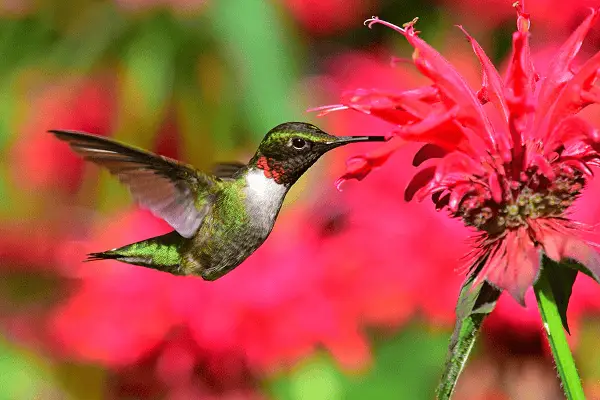
These hummingbirds are known for their incredible skills. They can flap their wings over 50 times a second and control their flight with great precision. They can fly up, down, sideways, or even backward, making them fun to watch.
In summer, these birds like to live in places like deciduous forests, forest edges, meadows, and by streams. They also enjoy orchards, old fields, gardens, parks, and backyards. They help pollinate by drinking nectar from flowers like trumpet creeper and cardinal flowers.
| Characteristic | Description |
|---|---|
| Feeding Habits | Hummingbirds eat nectar from flowers and tiny insects like mosquitoes and fruit flies. |
| Nesting | Their nests are small and made from grasses and spider webs. They’re usually found in deciduous trees. |
| Identification | The male’s throat is bright red, while the female’s is more green and white. |
| Migration | In the fall, they fly up to 500 miles across the Gulf of Mexico to reach their winter spots. |
It’s great to attract ruby-throated hummingbirds to your yard. Planting a garden with native flowers is a good way to do this. Make sure to keep your feeders clean and filled with sugar water to help these birds.
2. Rufous Hummingbird
- Scientific name – Selasphorus rufus
- Lifespan – 5 years (average)
- Size – (7 to 9 cm)
- Weight – (2 to 5 g)
- Wingspan – (11 to 11.4 cm)
The rufous hummingbird is not native to Virginia but is becoming more common there. It’s known for its bright orange back, belly, and tail. The male has a red throat patch. Females have a greenish back and tail, rusty sides, and an orange throat spot.
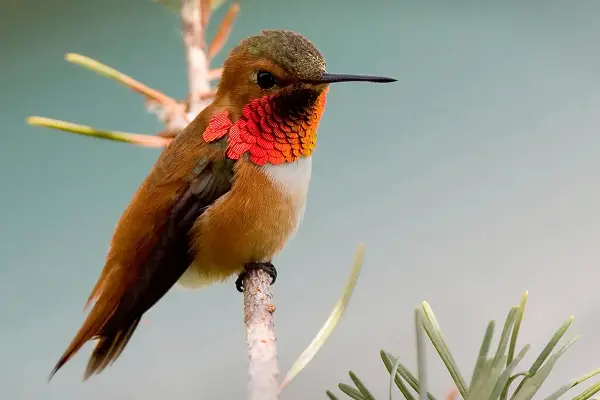
These hummingbird identification traits, along with their loud calls, make them stand out. They nest in trees, vines, and ferns. The female builds her nest with soft plant material and spider webs. She lays 2 or 3 white eggs, which take 2 weeks to hatch. The young birds leave the nest after another 2-3 weeks.
| Rufous Hummingbird Characteristics | Nesting Habits |
|---|---|
|
|
While the rufous hummingbird is rare in Virginia, sightings are increasing. As the climate changes, we’ll watch how their range and migration change too.
3. Calliope Hummingbird
- Scientific name – Selasphorus calliope
- Lifespan – 5 years (average)
- Size – (8 to 9 cm)
- Weight – (2.3 to 3.4 g)
- Wingspan –(10.5 to 11 cm)
The calliope hummingbird is a fascinating bird found in Virginia during migration. It’s known for its bright magenta throat feathers in males. These birds have straight bills and bronze-green feathers, making them stand out.
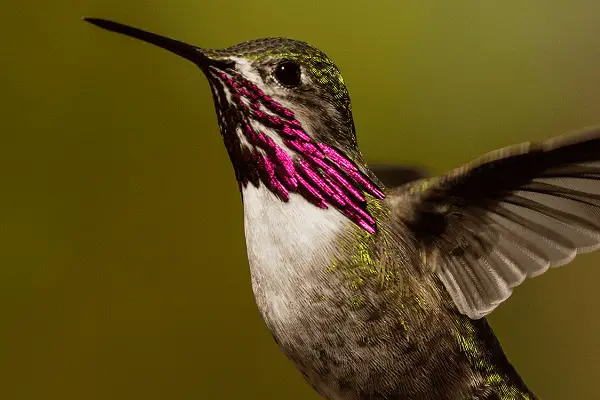
Calliope hummingbirds build their nests in evergreen trees. They make them look like pine cones. The nests are soft and spider-webbed, covered in bark, lichen, and moss. The female lays two white eggs and incubates them for two weeks. The babies stay in the nest for 18 to 21 days.
These birds eat nectar from flowers insects and sap. They can live in different places because they eat various foods. This makes them important to the Virginia hummingbird ecosystem.
Seeing a calliope hummingbird in Virginia is special. These small birds are full of life and color. Learning about them helps us appreciate the beauty of Virginia hummingbirds and nature.
4. Buff-bellied Hummingbird
- Scientific name – Amazilia yucatanensis
- Lifespan – 7 years (average)
- Size – (10 to 11 cm)
- Weight – (4 to 5 g)
- Wingspan – (14 to 15 cm)
In Virginia, the Buff-bellied Hummingbird is a standout species. It has a medium size and looks with a metallic bronze-green top and a black-tipped red bill. Males have a bright green throat, a rusty tail, and a buff-colored belly. Females are more subdued in color.

Nesting and Feeding Habits
The Buff-bellied Hummingbird builds complex nests in Virginia’s trees. They use flowers, bark, and spider webs for the nest. Females lay two white eggs per nest, which they keep warm for two weeks. The chicks leave the nest after about a week.
These hummingbirds eat flower nectar and small insects. As they move from flower to flower, they help pollinate Virginia’s plants. Their long bills let them get nectar from many types of flowers, helping the ecosystem.
On average, Buff-bellied Hummingbirds live about 7 years. They are 10 to 11 cm long and weigh 4 to 5 grams. Even though they’re from Mexico, they’ve been spotted in Virginia, making them a rare sight.
5. Allen’s Hummingbird
- Scientific name – Selasphorus sasin
- Lifespan – 3 years (average)
- Size – (7.5 to 9 cm)
- Weight – (2 to 4 g)
- Wingspan – (10 to 11 cm)
The Allen’s Hummingbird is a standout among Virginia’s hummingbirds. It’s small and has a straight bill, making it unique. The males have a bright reddish-orange throat and a shiny green back. They also have a copper-colored belly and tail. Females are less flashy but still beautiful, with a green back, copper flanks, and a reddish-orange throat patch.

These tiny birds make a sharp “tick” sound as they fly. They love to eat nectar and small insects. This helps them pollinate plants as they move around. Although rare in Virginia, some have been spotted, like one in Chester for months.
Allen’s Hummingbird is truly amazing. Its bright colors, interesting behavior, and role in nature make it special. If you’re in Virginia, look out for this rare and beautiful bird. It adds to the state’s rich bird life.
Check Our Previous Articles:
6. Black-chinned Hummingbird
- Scientific name – Archilochus alexandri
- Lifespan – 8 years (average)
- Size – (8 to 9 cm)
- Weight – (2.3 to 4.9 g)
- Wingspan – (10 to 11 cm)
In Virginia, the Black-chinned Hummingbird is a standout with its unique charm. It has a slender build and a straight bill. Its plumage is distinctive, making it stand out from other hummingbirds. The black-chinned hummingbird thrives in various habitats and enchants birdwatchers with its hummingbird vocalizations.

Identification and Vocalizations
The male black-chinned hummingbird has a purple throat that looks black. It also has a white spot behind the eye and whitish-grey underparts. The flanks are a dull metallic green. Females have a whitish throat and pale metallic green upperparts. They also have whitish underparts with a light green wash on the flanks. These features make the Black-chinned Hummingbird a joy to spot and observe.
These hummingbirds make a “chip” and “tick” sound. This adds to the variety of hummingbird vocalizations in Virginia. Despite their simple look, they are vital for pollination and ecosystem health. They add richness to the natural world.
7. Anna’s Hummingbird
- Scientific name – Calypte anna
- Lifespan – 5 years (average)
- Size – (10 to 11 cm)
- Weight – (3 to 6 g)
- Wingspan – (10 to 12 cm)
Anna’s Hummingbird is a standout among Virginia’s hummingbirds. It has a medium size and a special feature: the male’s bright rose-pink throat and crown. These stand out against its shiny green back. The females have a similar green color above but show a hint of pinkish-red on their throats.
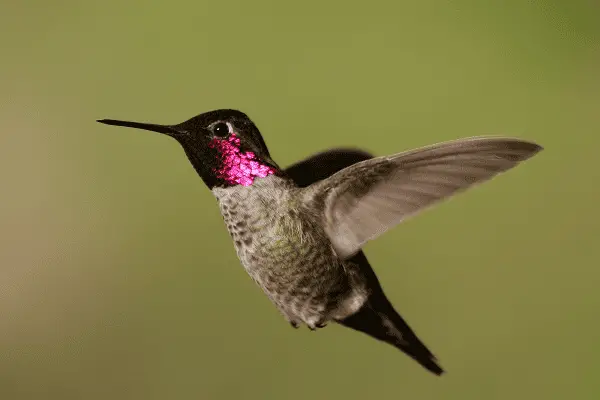
Anna’s Hummingbirds are great at building their nests. They pick oak or eucalyptus trees for this. They use soft plant materials like willow down, feathers, and spiderwebs to make a cup-shaped nest. They cover the nest with moss and lichen to blend in.
Their nesting habits are quite interesting. They lay two white eggs at a time. The eggs take about 16 days to hatch, and the chicks stay in the nest for about 20 days. These birds help pollinate plants by drinking nectar from flowers. They also eat insects and sap sometimes.
Anna’s Hummingbirds are very common along the Pacific Coast, including Virginia. Their beautiful looks and unique ways make them a joy to see in the area.
| Characteristic | Description |
|---|---|
| Adult Male Plumage | Brilliant rose-pink throat and crown, metallic green back |
| Female and Immature Plumage | Greenish upperparts, blackish wings, small pinkish throat patch, white spot behind eye |
| Courtship Display | Males climb up to 130 feet into the air before swooping to the ground with a burst of noise |
| Nesting Habits | Construct cup-shaped nests in trees and shrubs, using soft plant materials and camouflaging with moss and lichen |
| Egg Laying and Incubation | Typically lay two white eggs per clutch, incubating for around 16 days |
| Chick Rearing | Chicks spend approximately 20 days in the nest before fledging |
| Habitat and Distribution | Common in yards, parks, residential areas, and coastal regions along the Pacific Coast, including Virginia |
The Anna’s Hummingbird is a beautiful bird in Virginia. It has bright colors, interesting nesting habits, and helps pollinate plants. When you’re out exploring Virginia’s nature, look for these birds. You’ll see their amazing flying skills and how they find food.
Attracting Hummingbirds to Your Yard
To draw hummingbirds to your yard in Virginia, try a few simple steps. Start by filling nectar feeders with a mix of 4 parts water to 1 part sugar. This sugar water is a key food source for these birds. Make sure to keep the feeders clean to keep the hummingbirds coming back.
Next, plant native flowers that hummingbirds love, like trumpet creeper, bee balm, or cardinal flower. These plants have long, tube-shaped flowers that hummingbirds find irresistible. They also help the ecosystem by supporting insects that hummingbirds need for protein.
Using both nectar feeders and native plants will make your yard a welcoming spot for hummingbirds. With a bit of effort, you can watch these beautiful birds flit from flowers to feeders. This will bring a burst of energy to your outdoor area.
Frequently Asked Questions
Q1. What month are hummingbirds in Virginia?
Hummingbirds typically arrive in Virginia around early April and stay until late September. The exact timing can vary based on weather and migration patterns.
Q2. Are hummingbirds common in Virginia?
Yes, hummingbirds are quite common in Virginia, especially during the warmer months when they migrate northward from their wintering grounds.
Q3. When to put out a hummingbird feeder in Virginia?
It’s best to put out hummingbird feeders in Virginia by early to mid-April. This timing coincides with their usual arrival in the area. Keep the feeders up until late September to accommodate their departure.
Q4. When can I expect hummingbirds in my area?
You can expect hummingbirds in your area of Virginia starting from early April onwards. Keep an eye out for them as they migrate through or settle in for the summer breeding season.


